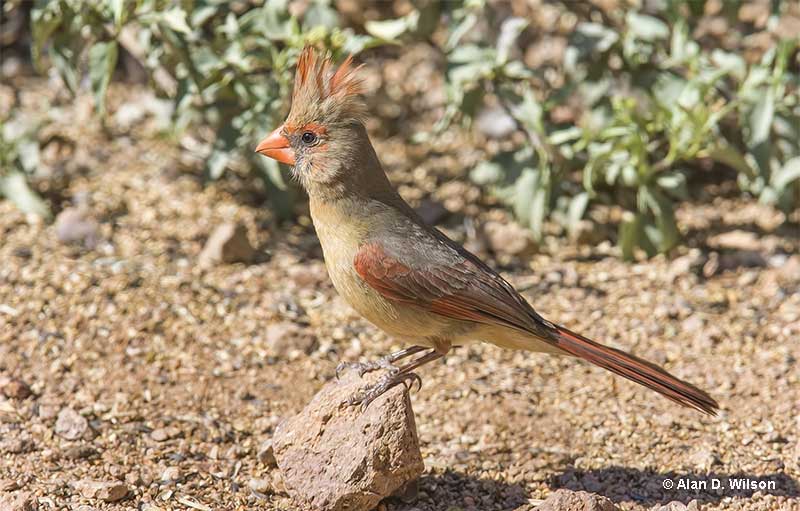
Virginia is bordered by the scenic ridges of the Appalachian Mountains to the west and the lovely waters of the Chesapeake Bay to the east. But do you know what’s the Virginia state bird?
More than 8,680,000 people make their home in this beautiful state. A lot of birds live in Virginia too; 487 species in 42,774 square miles of woodlands, peaceful coastal marshes, fields, and other habitats!
Virginia’s state bird is the Northern Cardinal. This bright red and black songbird lends a beautiful touch to gardens and other habitats in every corner of the state.
On this page
State Bird of Virginia
The Northern Cardinal has been the official state bird of Virginia since January 25th, 1950. This is the date when the state’s general assembly voted in favor of this beautiful red bird with the perky crest.
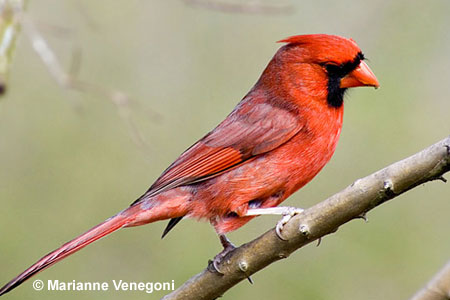
In one sense, they chose the Northern Cardinal because it was about time the Commonwealth voted on an official state bird. By 1950, various other states had already decided on several official state symbols. Even though Virginia had become a state in 1788, for most of the state’s history, the government had not made any initiative to pick an official bird.
That changed when officials finally decided to choose the state bird in 1950. As for the best candidate, there was no better option than the beautiful Northern Cardinal.
In Virginia, the bright colors and cheerful song of the Northern Cardinal have been appreciated and admired for centuries. Since it is one of the most common bird species in the state, any visitor to Virginia would be hard pressed not to hear and see several “Redbirds”.
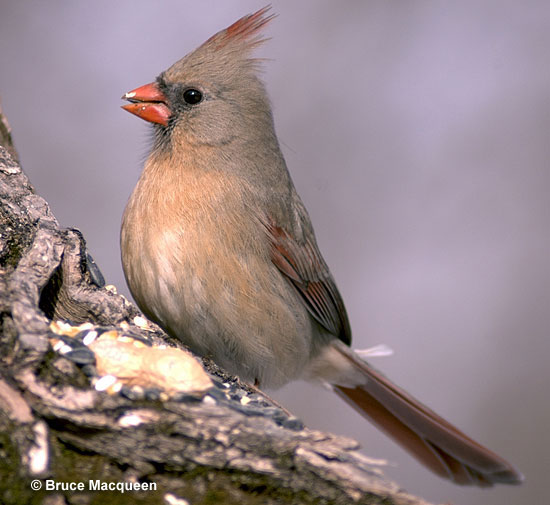
Female Northern Cardinal
Bright red males sing from bushes in gardens, parks, and woodlands throughout Virginia, and subtly beautiful females commonly nest in big gardens. Not to mention, the Northern Cardinal lends a bright touch to bird feeders, even during the winter.
Where can you find Northern Cardinals?
Northern Cardinals are common birds of second growth and woodlands. They love the edges of forest, shrubby habitats, and parklands. As long as bushes and vegetation are available, they also live in gardens, even in urban areas.
Although few of these beautiful birds live on city streets, in coastal marshes, and deep inside mature forest, they are common to abundant just about everywhere else. One of the easiest ways to see this species is to take a walk in a local park. Chances are, you will hear or see a cardinal!
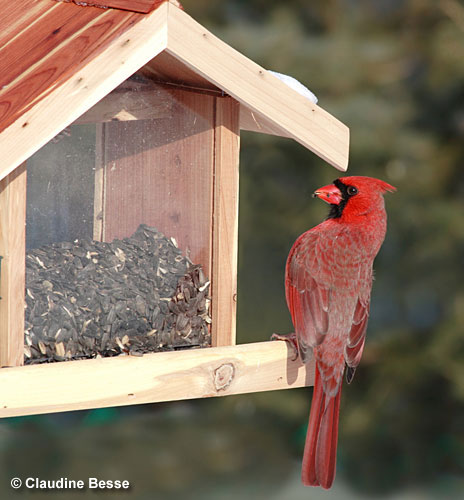
Northern Cardinals love bird feeders
Another good way to find cardinals is to put up a bird feeder and wait for them to appear. If there is at least some vegetation in the backyard, a Northern Cardinal or two will eventually pay a visit.
This special bird nests in brushy areas and in small trees. The female cardinal uses rootlets, twigs, and other bits of vegetation to build a cup nest that is usually hidden by thick vegetation.
Both parents feed the nestlings. The young birds leave the nest around ten days after hatching and the adults continue to watch after and feed them for at least two weeks more.
Fun Facts about the Northern Cardinal
- Europeans named this bird after the “cardinals” of the Catholic church because the bird’s plumage reminded them of their bright red robes.
- Rarely, a male Northern Cardinal has a genetic mutation called, “xanthochroism” where his red colors are replaced by yellow. Such rare birds are known as “Yellow Cardinals” and often make headlines.
- Although the Northern Cardinal is very common in southern states, it has “Northern” in its name because most other cardinal species live south of the border.
- Unlike many other birds, Northern Cardinals don’t need to migrate because they eat seeds during the winter months.
- Female cardinals sing too! Although they don’t sing as often as males, they sing while nesting to tell their mate to bring them food.
- This popular species is the official bird for 7 states!
- In spring, male Northern Cardinals commonly fight with their own reflection in windows and rearview mirrors. They are so intent on protecting their territory from other cardinals, they can’t resist driving the “other cardinal” away.
Identification
The Northern Cardinal is a fair-sized songbird around eight to nine inches in length, and with a wingspan of one foot. Both sexes have a perky crest, a strong, conical, orange or red beak, and a long, rounded tail.
Males are bright red with duskier red on their wings and tail. They also have jet black on their face and throat. Females are more subtly plumaged in shades of soft brown and buff. However, they still have bits of red in their crest, wings, and tail.
Young cardinals look like females but are even duller and are mostly dull grayish-brown. They can still be recognized by their crest and strong, conical beak.
Northern Cardinals have brief undulating flight on short, rounded wings.
What do Virginia’s State Birds Eat?
The Northern Cardinal eats a wide variety of insects and seeds. In spring and summer, it picks beetles and other bugs from the foliage of bushes and other low trees, and also from the ground. By fall, they feed more on a variety of seeds that they pick up from the ground. This species is also a regular visitor to bird feeders, especially in the winter.
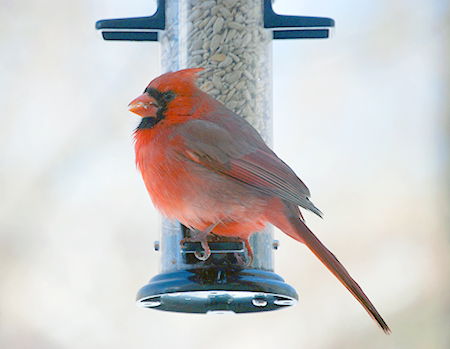
Call
Northern Cardinals make a sharp, loud chip note all year long. In spring and summer, they also sing a cheerful, whistled song. Males frequently sing from the top of a bush, house, or other elevated perch while females mostly sing from cover and while nesting. Their song is easily recognized and sounds like, “What cheer..what cheer..what cheer..chew chew chew chew chew chew”.
Behavior
This species mostly occurs in pairs although they can form small flocks in the winter. They spend most of their time foraging on or near the ground and often visit feeders. However, in general, they don’t seem to spend as much time as other species at the feeder. Northern Cardinals might only visit a feeder early in the morning, a few times during the day, and then late in the afternoon.
Other Birds in Virginia
According to eBird data, these are the next most common birds in Virginia.
Carolina Wren – A small buff and brown bird with a long, narrow white eyebrow and a longish, slightly curved, sharp beak.
American Crow – A big, noisy, all black bird with long wings that says, “Caw! Caw!”.
Blue Jay – A fair-sized, crested bird that is blue and gray above, gray and white below, and has some black on its face and wings.
Carolina Chickadee – A cute little gray and buff bird with a short, stubby beak, black cap, white cheeks, and black throat.
Tufted Titmouse – A cute, crested bird with a white face, blue-gray upperparts, and pale underparts.
See the most common hawk species & owl species
You Might Also Ask
What is the state bird of Virginia?
The state bird of Virginia is the Northern Cardinal.
Why is the Northern Cardinal the state bird of Virginia?
The Northern Cardinal is the state bird of Virginia because this beautiful bird is one of the most commonly seen birds in the state.
When did Virginia choose its state bird?
Virginia chose its state bird on January 25th, 1950.
What other states have the Northern Cardinal as their state bird?
Other states that have the Northern Cardinal as their state bird are Illinois, Indiana, Kentucky, North Carolina, Ohio, and West Virginia.
What was the previous state bird of Virginia?
Virginia has only had one state bird. Virginia didn’t have a state bird until the Northern Cardinal was chosen in 1950.

